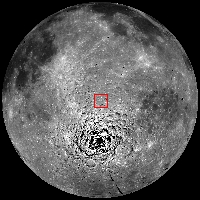 |
| Small craters and ejecta dot the landscape just over the crest of Manzinus M's rim, marked by the shadow on the bottom of the image. Several lineations run parallel to the rim while cross-cutting small craters. From the original 500 meter-wide field of view in the LROC Featured Image released June 4, 2012, LROC Narrow Angle Camera (NAC) observation M185718265L, LRO orbit 12449, March 7, 2012; resolution 0.5 meters [NASA/GSFC/Arizona State University]. |
Drew Enns
LROC News System
Today's Featured Image focuses on lineations on the rim of Manzinus M, a 6.2 kilometer crater at 63.545°S, 22.663°E.
The lineations might be a form of post-impact modification. Impact events take place in three stages: impact and compression, excavation, and modification. While compression and excavation take place quickly, modification describes everything that happens after the initial impact.
In large diameter (greater than 10-20 km) craters, modification can include faulting that creates terraces as the crater walls are too large and steep to hold together. Gravity wins and the unstable wall collapses.
However, walls of small craters (like Manzinus M) are stronger and do not usually collapse, thus the crater retains its initial bowl shape. The lineations on the rim are likely faults that developed some time after the crater formed. You can see that these fractures are more recent than the impact as they cross-cut smaller craters along the rim of the crater. These fractures probably opened as the smaller impacts formed on Manzinus M, steadily weakening the walls.
Manzinus M also contains spectacular impact melt deposits on its floor. As part of the tremendous energy released during the impact process, lunar crust is heated to temperatures well in excess of 1000°C (1832°F) and thus melted! There was so much melt that it ponded, cooled, froze, and eventually cracked. Look for the sharp boundary between the melt deposit and the wall of the crater in the full NAC image (link below). This boundary is all at the same elevation, like a ring in a bathtub (evidence that the melt was very fluid and ponded).
What other post impact processes are there in the full NAC frame, HERE?
Related Posts:
Ryder Spectacular
Slumping rim of Darwin C
Necho's Terraces
LROC News System
Today's Featured Image focuses on lineations on the rim of Manzinus M, a 6.2 kilometer crater at 63.545°S, 22.663°E.
The lineations might be a form of post-impact modification. Impact events take place in three stages: impact and compression, excavation, and modification. While compression and excavation take place quickly, modification describes everything that happens after the initial impact.
In large diameter (greater than 10-20 km) craters, modification can include faulting that creates terraces as the crater walls are too large and steep to hold together. Gravity wins and the unstable wall collapses.
 |
| LROC WAC context image for today's Featured Image (yellow arrow). Manzinus M is relatively young compared with the craters surrounding. The older craters provide snapshots of different stages of modification, fresh to degraded. The original 100 km wide LROC WAC context image accompanying the Featured Image release, June 4, 2012, can be viewed HERE [NASA/GSFC/Arizona State University]. |
Manzinus M also contains spectacular impact melt deposits on its floor. As part of the tremendous energy released during the impact process, lunar crust is heated to temperatures well in excess of 1000°C (1832°F) and thus melted! There was so much melt that it ponded, cooled, froze, and eventually cracked. Look for the sharp boundary between the melt deposit and the wall of the crater in the full NAC image (link below). This boundary is all at the same elevation, like a ring in a bathtub (evidence that the melt was very fluid and ponded).
What other post impact processes are there in the full NAC frame, HERE?
Related Posts:
Ryder Spectacular
Slumping rim of Darwin C
Necho's Terraces


No comments:
Post a Comment